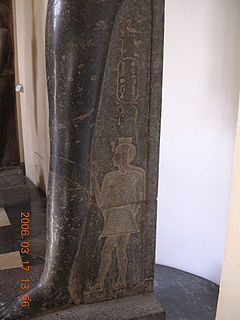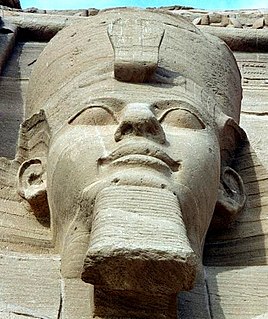
Sitre or Tia-Sitre, was the Great Royal Wife of Pharaoh Ramesses I of Egypt and mother of Seti I.
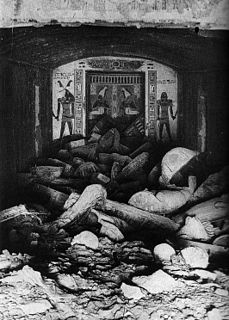
QV44 is one of several tombs located in the Valley of the Queens intended for the use of Ramesses III's sons. The painted reliefs decorating Khaemwaset E's tomb illustrate his ritual and symbolic journey in the Afterlife as he meets the main gods of that region as well as the genies who guard the gates of the kingdom of Osiris.

Tomb KV9 in Egypt's Valley of the Kings was originally constructed by Pharaoh Ramesses V. He was interred here, but his uncle, Ramesses VI, later reused the tomb as his own. The layout is typical of the 20th dynasty – the Ramesside period – and is much simpler than that of Ramesses III's tomb (KV11). The workmen accidentally broke into KV12 as they dug one of the corridors.
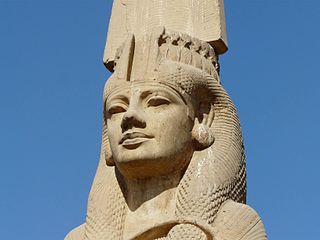
Meritamen was a daughter and later Great Royal Wife of Pharaoh Ramesses the Great.
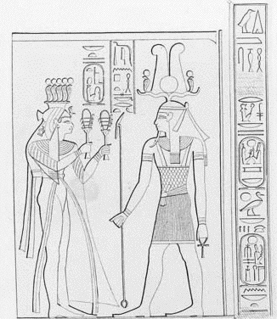
Iset Ta-Hemdjert or Isis Ta-Hemdjert, simply called Isis in her tomb, was an Ancient Egyptian queen of the twentieth dynasty; the Great Royal Wife of Ramesses III and the Royal Mother of Ramesses VI.

The Book of the Earth is an Ancient Egyptian funerary text that has been called many names such as The Creation of the Sun Disk and the Book of Aker. The Book primarily appears on the tombs of Merneptah, Twosret, Ramesses III, Ramesses VI, and Ramesses VII and serves as a counterpart to the Book of Caverns.

The Ancient Egyptian Noble Paser was vizier, in the reigns of Seti I and Ramesses II, during the 19th dynasty. He would later also become High Priest of Amun.

Theban Tomb TT2 is located in Deir el-Medina, part of the Theban Necropolis, on the west bank of the Nile, opposite to Luxor. It is the burial place of the Ancient Egyptian official, Khabekhnet, and his family. Khabekhnet was Servant in the Place of Truth, during the reign of Ramesses II.
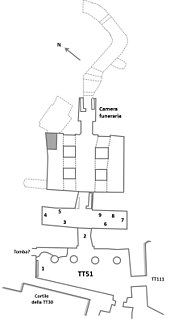
Theban Tomb TT51 is located in Sheikh Abd el-Qurna, part of the Theban Necropolis, on the west bank of the Nile, opposite to Luxor. It is the burial place of the Ancient Egyptian official, Userhat who was First Prophet of Sethi I, during the 19th Dynasty.

Henuttawy was an ancient Egyptian princess of the 19th dynasty.
Tyti was an ancient Egyptian queen of the 20th dynasty. A wife and sister of Ramesses III and possibly the mother of Ramesses IV.

The Theban Tomb TT214 is located in Deir el-Medina, part of the Theban Necropolis, on the west bank of the Nile, opposite to Luxor.

QV71 is the tomb of Bintanath, the daughter and Great Wife of Ramesses II, in Egypt's Valley of the Queens. It was mentioned by Champollion and Lepsius, and later excavated by Ernesto Schiaparelli.
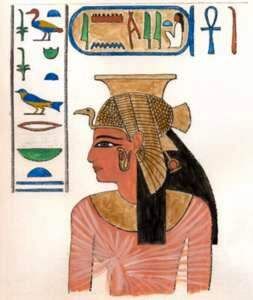
QV68 is the tomb of Meritamen, the daughter and Great Wife of Ramesses II, in Egypt's Valley of the Queens. It was mentioned by Champollion and Lepsius, and later excavated by Ernesto Schiaparelli.

QV60 is the tomb of Nebettawy, the daughter and Great Wife of Ramesses II, in Egypt's Valley of the Queens. It was mentioned by Champollion and Lepsius, and later excavated by Ernesto Schiaparelli.

QV80 is the tomb of (Mut-)Tuya, the Great Royal Wife of Seti I, and the mother of Ramses II, in Egypt's Valley of the Queens.
Tanejemet of Tanedjemy is a King's daughter and King's Wife from the New Kingdom. She is possibly a daughter of Ramesses I and wife of Sety I.

Tia was an ancient Egyptian high official under king Ramses II. His main title was that of an overseer of the treasuries. Tia was married to a woman with the same name, the princess Tia who was sister of Ramses II.
Hori was an ancient Egyptian High Priest of Osiris at Abydos, during the reign of pharaohs Ramesses II.

Yuni served as Head of the-stable-of-Seti-I, Charioteer of His Majesty, and Chief of the Medjay before becoming Viceroy during the reign of Seti I. He would use some of these titles simultaneously. On a stela from Abydos -now in the Cairo Museum - the inscription reads:
